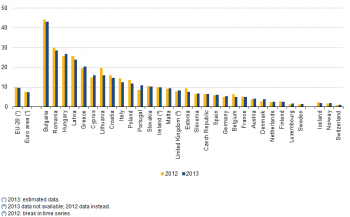Archive:People at risk of poverty or social exclusion
Data extracted in December 2015. Most recent data: Further Eurostat information, Main tables and Database.
One of the five headline targets of the Europe 2020 headline indicators is to reduce poverty by lifting at least 20 million people out of the risk of poverty or social exclusion by 2020. This article presents geographical and temporal comparisons of the monetary and non-monetary elements of the indicator that describes poverty and social exclusion in the European Union (EU) using the most recent data (2013 and 2014) from the EU statistics on income and living conditions (EU-SILC). Comparisons over the most recent years enable, inter alia, analysis of the impact of the economic crisis and the austerity measures taken to overcome the crisis on the Europe 2020 headline target.
Main statistical findings
In 2014, 122.3 million people, or 24.4 % (see Figure 1) of the population in the EU-28 were at risk of poverty or social exclusion (AROPE), compared with 24.5 % in 2013. This means that these people were at least in one of the following conditions:
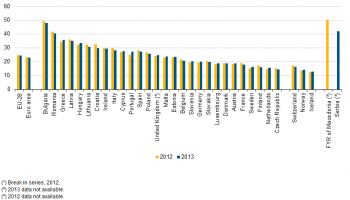
(%)
Source: Eurostat (ilc_peps01)
- at-risk-of-poverty after social transfers (income poverty);
- severely materially deprived or
- living in households with very low work intensity.
The reduction of the number of persons at risk of poverty or social exclusion in the EU is one of the key targets of the Europe 2020 strategy.
The at-risk-of-poverty-or-social-exclusion figure, for the EU-28 average, calculated as a weighted average of national results, masks considerable variations between EU Member States. In 2014, more than a third of the population was at risk of poverty or social exclusion in three EU Member States: Romania (40.2 %), Bulgaria (40.1 %) and Greece (36.0 %). At the other end of the scale, the lowest shares of persons being at risk of poverty or social exclusion were recorded in Finland (17.3 %), Sweden (16.9 %), the Netherlands (16.5 %) and the Czech Republic (14.8 %).
Overall, the at-risk-of-poverty rate has slightly decreased at EU-28 level between 2013 and 2014 by 0.1 percentage points (pp). It rose by 1.9 pp in Spain and 1.3 pp in Finland, decreasing by 7.9 pp in Bulgaria and 3.5 pp in Lithuania.
Children and active-age people more at risk of poverty or social exclusion than elderly people in several countries

(% of specified population)
Source: Eurostat (ilc_peps01)
With a rate of 27.8 % in the EU-28 (see Table 1), children were at greater risk of poverty or social exclusion in 2014 than the rest of the population in 20 of the 28 EU Member States. The largest gaps (difference between the AROPE rates for the specific age groups) between children and the total population were observed in Romania, Hungary and Malta; in these countries the AROPE rate for children was at least 7.5 pp higher than the rate for the total population. The situation was relatively better for children than adults in Denmark, Cyprus, Slovenia, Germany, Finland, Sweden, Croatia, Estonia, as well as in Norway.
The percentage of children living in a household at risk of poverty or social exclusion ranged from 14.5 % in Denmark, 15.6 % in Finland and 16.7 % in Sweden to more than 40.0 % in Hungary, Bulgaria and Romania. The main factors affecting child poverty are the labour market situation of the parents, which is linked to their level of education, the composition of the household in which the children live and the effectiveness of government intervention through income support and the provision of enabling services. There are also more vulnerable groups of children, such as those with migrant parents that deserve particular attention.
The elderly faced a lower risk of poverty or social exclusion in 2014 than the overall population both at EU-28 level (17.8 % as opposed to 24.4 %) and in 23 out of the 28 EU Member States. The risk of poverty or social exclusion faced by people aged 65 or more in 2014 ranged from 6.4 % in Luxembourg to 47.8 % in Bulgaria. These differences in the relative situation of the elderly depend on a number of factors including the features of the pension systems for current pensioners and the age and gender structure of the elderly population, since elderly women and the very old tend to face much higher risks in some countries.
Income poverty: 17.2 % of the population in the EU-28 facing risk of poverty
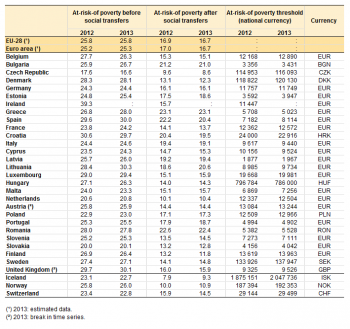
(%)
Source: Eurostat (ilc_li10) (ilc_li02) (ilc_li01)
Looking at each of the three elements contributing to being at risk of poverty or social exclusion, 17.2 % of the population in the EU-28 in 2014 were at risk of poverty after social transfers (see Table 2), meaning that their disposable income was below their national at-risk-of-poverty threshold. The at-risk-of-poverty rate after social transfers has increased slightly in the EU-28 compared with 2013. The highest at-risk-of-poverty rates were observed in Romania and Spain (25.4 % and 22.2 % respectively), Greece (22.1 %), Bulgaria and Estonia (both 21.8 %) and the lowest in Finland (12.8 %), Slovakia (12.6 %), Denmark (11.9 %), the Netherlands (11.6 %) and the Czech Republic (9.7 %). It is important to note that the at-risk-of-poverty rate is a relative measure of poverty and that the poverty threshold varies greatly between EU Member States. The threshold varies also over time and in a number of EU Member States it has fallen in recent years in the aftermath of the financial and economic crisis. When considering country-specific situations, the risk of poverty (after social transfers) increased the most in Romania (3.0 pp) in 2014 and decreased the most in Lithuania (– 1.5 pp).
In Cyprus, despite the 9.3 % fall in the median income between 2013 and 2014 the at-risk-of-poverty rates after social transfers only dropped by 0.9 pp implying that the situation for the people below the threshold only evolved slightly. The median income in national currency also dropped by 8.3 % in Greece between 2013 and 2014, as did its at-risk-of-poverty rate. This implies that a number of people in these two EU Member States who were around the poverty threshold in 2013 moved above it even if their situation did not significantly change in 2014 given the lowering of the threshold caused by the fall in the median income. Exactly the opposite is true for Spain, for which the median income fell by 1.9 % while the at-risk-of-poverty rate increased, implying that the number of people exposed to the risk of poverty has increased from 2013 to 2014 and their overall situation — from an income perspective — has worsened.
The at-risk-of-poverty rate before social transfers measures a hypothetical situation where social transfers are absent (pensions not being considered as a social transfer). Comparing this with the standard at-risk-of-poverty rate (after social transfers) shows that such transfers have an important redistributive effect that helps reducing the number of people who are at-risk-of-poverty. In each country, these rates are calculated with the same poverty threshold, i.e. including social transfers in the total household income.
If we consider the at-risk-of-poverty rate before social transfers a slightly different picture emerges: at-risk-of-poverty rate remains almost stable between 2013 and 2014 in the EU-28 while it rises a bit more in some EU Member States, with the largest increases registered in Belgium, Finland, Portugal (each 1.2 pp) and Sweden (1.4 pp).
As already discussed, the at-risk-of-poverty rate is sensitive to sudden changes in income distribution. Denmark, Luxembourg and Lithuania are three characteristic cases. In these countries the at-risk-of-poverty threshold increased more or less significantly between 2013 and 2014. However, the at-risk-of-poverty rate after social transfers increased in Luxembourg while it decreased in Lithuania and remained stable in Denmark. In the case of Luxembourg this implies an overall shift of the income distribution towards lower incomes, while in cases like Lithuania the evolution of the data could be explained by the fact that, for instance, different sources of income (e.g. pensions and social benefits as opposed to wages and salaries) are not all hit at the same time, or that particular groups of the population are mostly hit by the crisis (e.g. lowest income groups).
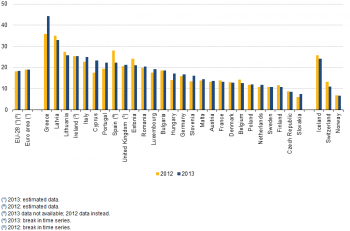
(%)
Source: Eurostat (ilc_li22b)
To allow for these sudden fluctuations in poverty thresholds and in order to avoid misleading results in periods of rapid and general economic deterioration, Eurostat calculates the at-risk-of-poverty indicator anchored in time. This indicator keeps the poverty threshold fixed in real terms over a longer period of time and therefore controls the effects of a moving poverty threshold. Figure 2 presents the at-risk-of-poverty rates anchored in 2008 and the results suggest that between 2013 and 2014 the largest increases were observed in Cyprus (+ 8.0 pp), Greece (+ 3.7 pp) and Spain (+ 3.2 pp), while Malta (– 2.9 pp) and Latvia (– 5.0 pp) reported the largest decreases. In absolute terms, 18.8 % of the population in the EU-28 in 2014, were at risk of poverty (anchored in 2008), which is higher by 1.6 pp than the standard [1] at-risk-of-poverty-rate after social transfers (17.2 %). Greece (48.0 %), Cyprus (31.3 %), Latvia (28.0 %) had the largest anchored poverty rates in 2014, while the Czech Republic (9.2 %) and Slovakia (8.1 %) reported the lowest rates.
Work intensity: 11.0 % of the population in the EU-28 living in households with very low work intensity
Low work intensity refers to the ratio between the number of months that household members of working age (aged 18–59, not being a student aged 18–24) worked during the income reference year, and the total number of months that could theoretically have been worked by the same household members. For persons who declared that they worked part-time, the number of months in terms of full time equivalents is estimated on the basis of the number of hours usually worked at the time of the interview.
People living in households with very low work intensity are defined as people of all ages (from 0–59 years) living in households where the adults (those aged 18–59, but excluding student aged 18–24) worked less than 20 % of their total potential during the previous 12 months.
Following the definition, 11.1 % of the population aged 0–59 in the EU-28 lived in households with very low work intensity. In 2014, at Member State level the situation was as follows: Ireland (21.0 %), Greece (17.2 %), Spain (17.1 %), Croatia (14.7 %) and Belgium (14.6 %) were the Member States with the highest proportion of households with very low work intensity, while Poland (7.3 %), Slovakia (7.1 %), Romania (6.4 %), Sweden (6.4 %) and Luxembourg (6.1 %) recorded the lowest proportions (see Figure 3).
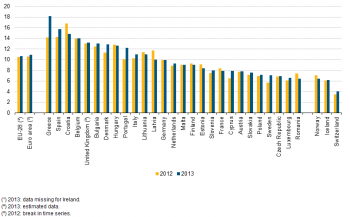
(%)
Source: Eurostat (ilc_lvhl11)
In 2014, compared with 2013, the share of persons aged 0–59 living in households with very low work intensity increased in most EU Member States, except Ireland (– 2.9 pp), Lithuania (– 2.2 pp), the United Kingdom (– 1.0 pp), Greece (– 1.0 pp), Bulgaria (– 0.9 %), Estonia (– 0.8 %), Sweden (– 0.7 %), Luxembourg, Slovakia (both – 0.5 %), Latvia, Hungary (both – 0.4 %) and Croatia (– 0.1 %).
Material deprivation: 9.0 % of the population in the EU-28 were severely materially deprived
Material deprivation rates complement the social exclusion picture by providing an estimate of the proportion of people whose living conditions are severely affected by a lack of resources. The severe material deprivation rate represents the proportion of people who cannot afford at least four of the nine following items:
- having arrears on mortgage or rent payments, utility bills, hire purchase instalments or other loan payments;
- being able to afford one week’s annual holiday away from home;
- being able to afford a meal with meat, chicken, fish (or vegetarian equivalent) every second day;
- being able to face unexpected financial expenses;
- being able to buy a telephone (including mobile phone);
- being able to buy a colour television;
- being able to buy a washing machine;
- being able to buy a car;
- being able to afford heating to keep the house warm.
In the EU-28, 9.0 % (see Figure 4) of the population were severely materially deprived. The share of those severely materially deprived varied significantly among EU Member States. On one hand, 3.2 % in the Netherlands and Denmark, 2.8 % in Finland, 1.4 % in Luxembourg and only 0.7 % of the population was severely deprived in Sweden. On the other hand, the deprivation rate was more than 20.0 % in Romania and 33.1 % in Bulgaria.
While overall at EU level, severe material deprivation decreased by 0.6 pp between 2013 and 2014, in some EU Member States the situation was different; Greece 1.2 pp, Spain 0.9 pp, Belgium 0.8 pp, Malta and the Netherlands with 0.7 pp, Finland 0.3 pp and the Czech Republic 0.1 pp.
Unexpected expenses: 38.9 % of the population in the EU-28 could not afford unexpected financial expenses
Among material deprivation items, facing unexpected expenses showed the greatest variation in 2014 at EU-28 level compared with 2013. This item measures the ability of a household to cover — from their own resources — an unexpected expense amounting to a fraction (1/12) of the poverty threshold. The amount varies between countries from about EUR 110 in Romania to about EUR 1 716 in Luxembourg (see Table 2).
In 2014, 38.9 % of the EU-28 population (see Figure 5) reported difficulties in facing such unexpected expenses. This represents a decrease of 0.9 pp compared with 2013.
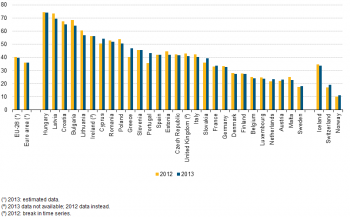
(%)
Source: Eurostat (ilc_mdes04)
There are considerable variations between EU Member States. The percentage of people reporting such difficulties ranged from 24.0 % or less in Belgium, Austria, Luxembourg, the Netherlands and Sweden to more than 60.0 % in Hungary, Latvia, and Croatia. Compared with 2013, the rates of those facing unexpected expenses increased the most in Greece (+ 4.7 pp) and Cyprus (+ 5.5 pp). At the same time it decreased substantially in Bulgaria (– 14.5 pp) and by more than 2 pp in Estonia (– 2.8 pp), the United Kingdom and Lithuania (each – 2.2 pp) and Latvia (– 2.1 pp).
Data sources and availability
The data used in this section are primarily derived from data from EU statistics on income and living conditions (EU-SILC). The reference population is all private households and their current members residing in the territory of an EU Member State at the time of data collection; persons living in collective households and in institutions are generally excluded from the target population. The EU-28 aggregate is a population-weighted average of individual national figures.
Context
At the Laeken European Council in December 2001, European heads of state and government endorsed a first set of common statistical indicators for social exclusion and poverty that are subject to a continuing process of refinement by the indicators sub-group (ISG) of the social protection committee (SPC). These indicators are an essential element in the open method of coordination to monitor the progress made by the EU Member States in alleviating poverty and social exclusion. EU-SILC is the reference source for EU statistics on income and living conditions and, in particular, for indicators concerning social inclusion. In the context of the Europe 2020 strategy, the European Council adopted in June 2010 a headline target for social inclusion — namely, that by 2020 there should be at least 20 million fewer people in the EU who are at risk of poverty or social exclusion. EU-SILC is the source used to monitor progress towards this headline target, which is measured through an indicator that combines the at-risk-of-poverty rate, the severe material deprivation rate, and the proportion of people living in households with very low work intensity.
Persons at risk of poverty are those living in a household with an equivalised disposable income below the risk-of-poverty threshold, which is set at 60 % of the national median equivalised disposable income (after social transfers). The equivalised income is calculated by dividing the total household income by its size determined after applying the following weights: 1.0 to the first adult, 0.5 to each other household members aged 14 or over and 0.3 to each household member aged less than 14 years old.
The total number of people at risk of poverty or social exclusion is lower than the sum of the numbers of people in each of the three forms of poverty or social exclusion as some persons are affected simultaneously by more than one of these situations.
See also
- Housing conditions
- Housing statistics
- Income distribution statistics
- Material deprivation and low work intensity statistics
- Social inclusion statistics
Further Eurostat information
Publications
- More than 120 million persons at risk of poverty or social exclusion in 2013 — Press Release 11/2014
- 23 % of EU citizens were at risk of poverty or social exclusion in 2010 - Statistics in focus 9/2012
- Children were the age group at the highest risk of poverty or social exclusion in 2011 - Statistics in focus 4/2013
- European social statistics (2013) - Statistical books
- Living standards falling in most Member States Statistics in focus 8/2013
- In 2011, 24 % of the population were at risk of poverty or social exclusion – News release
- In 2011, 27 % of children aged less than 18 were at risk of poverty or social exclusion – News release
- The 9 poorest countries catching up on income per capita - Statistics in focus 16/2011
Main tables
Database
- Living conditions and welfare (livcon), see:
- Income and living conditions (ilc)
- People at risk of poverty or social exclusion (Europe 2020 strategy) (ilc_pe)
- Main indicator - Europe 2020 target on poverty and social exclusion (ilc_peps)
- Income distribution and monetary poverty (ilc_ip)
- Monetary poverty (ilc_li)
- Living conditions (ilc_lv)
- Health and labour conditions (ilc_lvhl)
- Material deprivation (ilc_md)
- Material deprivation by dimension (ilc_mddd)
- Economic strain (ilc_mdes)
- People at risk of poverty or social exclusion (Europe 2020 strategy) (ilc_pe)
Dedicated section
- Employment and social policy indicators
- Europe 2020 indicators
- Income, social inclusion and living conditions
- Quality of life indicators
Methodology
- Income and living conditions (ESMS metadata file — ilc_esms)
- Measuring material deprivation in the EU — Indicators for the whole population and child-specific indicators (Statistical working papers)
Source data for tables and figures (MS Excel)
Other information
- Regulation 1177/2003 of 16 June 2003 concerning Community statistics on income and living conditions (EU-SILC)
- Regulation 1553/2005 of 7 September 2005 amending Regulation 1177/2003 concerning Community statistics on income and living conditions (EU-SILC)
- Regulation 1791/2006 of 20 November 2006 adapting certain Regulations and Decisions in the fields of ... statistics, ..., by reason of the accession of Bulgaria and Romania
External links
- Employment and Social Developments in Europe (2013)
- Employment and Social Situation Quarterly Review - September 2013
- OECD - Better Life Initiative: Measuring Well-being and Progress
- The social dimension of the EUROPE 2020 strategy - A report of the social protection committee (2011)
Notes
- ↑ The term ‘standard’ refers to the typical (not anchored in time) risk at poverty indicator after social transfers where the poverty threshold is estimated according to the income distribution of the survey year (2014). This indicator does not measure wealth or poverty, but low income in comparison to other residents in that country, which does not necessarily imply a low standard of living. The risk at poverty rated anchored in 2008 provides complementary information because it keeps the poverty threshold fixed in real terms over the period 2008–14 and therefore gives a better picture of the evolution of monetary poverty in particular when median income decreases.
